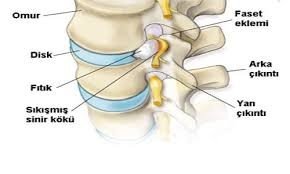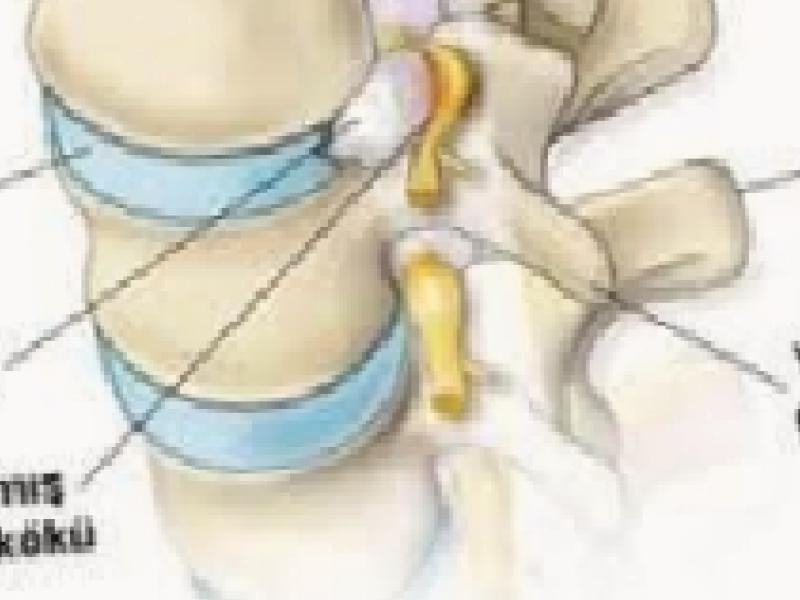
CAUSES AND TREATMENT METHODS OF LACK PAIN
Low back pain is one of the most common health problems. Low back pain, which is among the most common pain after headaches, occurs in 85% of people at some point in their lives.
Lumbar vertebrae carry more loads due to their mobility. At the same time, the spines in this region are more affected by various impacts, loads and diseases. Inside the spine, the spinal cord passes through layers of sheaths like a cylinder. The vertebrae are separated by pads called discs, which contain a very thick liquid. The outer part of these pads consists of a harder layer. With the advancement of age and impacts, these pads begin to wear out and as a result of the thinning of the outer layer, they are torn by lifting a heavy load and sudden movement and begin to put pressure on the nerve. This is how the disease, which is called lumbar hernia among the people, develops.
Low back pain can occur due to many reasons, not just herniated disc. Poor posture, lack of exercise, excess weight are the biggest enemies of the waist. Many low back pain occurs when people do not use their back properly. As a result, weakness of the lower back muscles develops. Pain may occur as a result of weakness of the lower back muscles. These are certain activities that are done regularly, for example; It can occur due to reasons such as bending, standing, sitting or lifting heavy. In the same way, excessive voltage may occur during a sports activity or a traffic accident. As a result, discs may rupture. Again, as a result of some structural disorders, for example; Congenital defects, curvature of the spine called scoliosis, or a joint in the spine that is tilted forward or backward (listesis) can cause very severe low back pain. As a result of some disorders in the abdominal organs, pain that is reflected in the lower back may occur. Low back pain can also be seen in women in various gynecological problems. Again, cancers of the abdomen and gynecological organs can be reflected in the form of pain in the lower back. Therefore, the patient with low back pain should be examined in detail and seriously. At this point, the importance of the physician is great. The correct diagnosis can only be made by the physician’s examination, physical examination, various laboratory and imaging methods. Here, the physician should investigate the situation in detail by asking when your pain started, how it started, and to which area it spreads. Diagnosis is possible with a detailed physical examination and imaging. If low back pain is not diagnosed and overlooked in this way, then untreatable situations may occur.
Causes of Low Back Pain
Facet Syndrome
Facet syndrome is among the common causes of low back pain. Facet joints are small joints that hold each vertebra that make up our spine together, and there are two on each vertebral bone on the right and left. The structure of these joints, which is of great importance in the mobility of the spine, may deteriorate depending on age and trauma and may cause serious low back pain. Low back pain due to facet syndrome is exacerbated by leaning backwards and turning to the side. This type of pain can be controlled with interventional methods such as facet joint injection and facet joint denervation.
The nerves of the facet joints do not provide the movement of the muscles, they only carry the pain signals to the brain. Facet joint denervation is the inhibition of the communication of these nerves. The most modern method used to achieve this is “radiofrequency thermocoagulation”, which is based on the application of controlled heat to the nerve. These interventional methods are only a part of the treatment. Another point, which is at least as important as these, is to give back training to the patients after the treatment. The aim here is to teach the exercise program that should be done after the treatment and the behaviors that should be done and avoided in order to treat the body correctly. Only in this way is it possible to have a healthy spine.
Spondylolisthesis
Spondylolisthesis, also known as lumbar slippage among the people, occurs in the lumbar region of the spine, where a vertebra here is pushed further than the previous vertebra. In general, severe low back pain is characterized by pain radiating to one or both legs. In severe shifts, the patient may have neurological deficits. The pain is usually more severe when sitting and getting up, increasing with movement.
In such patients, if there is neurological loss, an operation is required. If there is no neurological loss, epidural steroid injection and facet nerve blocks can be applied.
Failed Back Surgery Syndrome
Failed back surgery syndrome is used to describe patients who underwent surgery for a herniated disc, but whose complaints did not improve or new pain complaints emerged after the surgery. is a term.
Depending on the reason for the failure of the surgery, the treatment to be performed is very diverse. Some causes of failed back surgery syndrome; Changes related to surgery such as scar tissue formation around the nerve in the operation area, re-herniation of the disc in the operation area, herniation of another disc leading to the same or similar complaints, and application of the operation to the wrong level or unsuccessfully.
Epidural steroid injection may be helpful in the treatment of failed back surgery syndrome; better, a transforaminal steroid injection can be applied, which allows the drug to be applied directly to the surgical area. If adhesions formed around the nerve at the operation site and causing complaints by applying pressure to the nerve are detected in the contrast-enhanced MRI taken after the surgery, epidural lysis is performed in order to dissolve these tissues. It would be appropriate to re-evaluate the patient, whose pain complaint persists despite various treatment methods, by a neurosurgeon. Patients who do not have an indication for surgery may require applications such as spinal cord battery application and opioid drug therapy.
Herniated disc (Lumbar Disc Herniation)
The spine carries the weight of the body by keeping the human body standing. It allows the body to move in all directions. It protects the spinal cord with its canal structure. The lumbar spine consists of five vertebrae and discs.

This is the place that carries the most body weight. Therefore, the discs here wear out more easily. The disc consists of the core and the capsule protecting it. If the protective part is torn by any force and the nucleus herniates towards the posterior canal, it presses on the nerves going from here to the legs, preventing these nerves from working, and as a result, pain, numbness and weakness may occur in the lower back and legs. A herniated disc can be seen in 20-30% of healthy adults. However, not every lumbar hernia causes pain.
Especially overweight people and those who work in heavy work are at higher risk of developing herniated disc.
Symptoms of Lumbar Hernia
Leg pain, which is the most common symptom of hernia and that the nerve in the waist is under pressure, can be unilateral or bilateral. In addition, symptoms such as numbness, tingling, and burning in the area where the nerve under pressure disperses may accompany this pain. If the nerves that provide urination and large toilet are under pressure, serious symptoms such as inability to urinate and large toilet and not feeling it may occur.

Physical examination has the most important place in the diagnosis of herniated disc. In the examination, especially for the nerve under pressure, low back movements, straight leg lifting test and stretching test are applied in the patient lying on his back. During these tests, the pain in the leg intensifies. The sensation in the area where the nerves are scattered and the same area sensation on the opposite side are compared to see if there is numbness. For motor power loss, the movements of the ankle and big toes are compared.
If it is concluded that the nerve is under pressure in the lumbar region as a result of the examination, the diagnosis is made by imaging methods such as direct X-ray, magnetic resonance imaging, and myelography.
Treatment
80% of patients diagnosed with lumbar hernia can be treated without surgery. There are different forms of treatment for lumbar hernia. Before the treatment of herniated disc, the patient should be evaluated in detail and treated accordingly. If the patient has a general loss of sensation and loss of sensation, as well as urinary incontinence or stool incontinence, immediate surgical intervention is required. Apart from this, there is a wide range of treatment algorithms, starting with drugs, bed rest, physical therapy methods, various injection techniques in the lumbar region and surgical methods. Which treatment will be applied may differ according to the condition of the patient, the stage of the disease, the success or failure of the previous treatment methods.
It is also known that various methods other than medicine are applied in lumbar hernia. These methods, which can be defined with a general name as waist pulling, are unfortunately applied indiscriminately, although they must be applied very meticulously and carefully even by the physician. As a result of this, it is possible to damage both the nerves and the spinal cord directly as a result of the compression of the nerves coming out of the spinal cord between the vertebrae as a result of a wrong pull. As a result of this destruction, many disorders may occur in the patient, including paralysis. Another important point is that not all low back pain is related to herniated disc as mentioned before. In the structure rich in muscles and nerves in this region, patients may experience pain due to many reasons mentioned before. Only a physician can make the differential diagnosis of these pains. If it is a method that the physician does not apply, it will be wrong.
In recent years, various new treatment methods that can be very effective have been developed in addition to physical therapy and neurosurgery methods in the treatment of low back pain. Among these methods, certain methods applied by entering the areas where the nerves are under direct pressure with a needle, giving drugs that can relieve the pressure in that area, and entering the same area with thin probes called catheters, give very successful results. Again, in patients who have had herniated disc surgery many times, one of the methods applied in the last ten years, in the case called unsuccessful low back patients, is perhaps the most important spinal cord piles. Stimulations made through electrodes placed in this area can give extremely effective results in patients.

